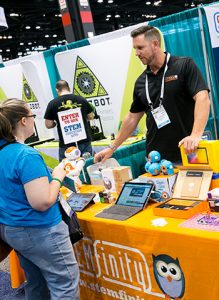
The 2017 ALA Annual Conference and Exhibition in Chicago featured an impressive array of technology products and services for libraries. Organizations of all sizes were represented, ranging from corporate giants with their large booth installations to smaller companies with simpler tabletop displays. This mix reflects the current state of the library technology industry where large, consolidated, and diversified corporations dominate; midsized companies continue to create and support a narrower set of products and services; and small start-ups appear, bringing new energy and innovation.
I probably spend more time in the exhibit hall than most conference attendees—you may have seen me browsing the aisles or rushing to my next appointment. The meetings I have with company executives and product experts inform much of my research and writing for months to come as a chronicler of the library technology industry. Since the ALA Annual Conference is the largest exhibition of its kind in the world, space permits only selected highlights and not a comprehensive report. Here is a quick virtual tour of the exhibit hall, which begins with the large and familiar brands and will finish with some of the more recent start-ups and innovators.
The big leagues
Google was the largest organization represented. An occasional ALA exhibitor, this year Google was promoting Libraries Ready to Code, a joint initiative with ALA that is making $500,000 available for the creation of tools and resources for libraries to foster the development of programming expertise by youth in their communities.
ProQuest always takes a prominent place in the hall, now with Ex Libris, which it acquired in late 2015, stewarding most of its tech-related products and services. Its Alma platform is in full force in sales and implementations among large academic, research, and national libraries, but Ex Libris is now turning up the volume on newer additions to its product family, such as its Leganto course list–management software. Summon has joined Primo in the lineup of Ex Libris discovery services. A new interface for Primo was on view, as well as a new look for the staff side of Alma.
EBSCO Information Services likewise divides its exhibit-hall displays between a massive arsenal of databases and other content products and its ever-growing technology interests. For the last year or so, EBSCO has been energetically promoting FOLIO (The Future of Libraries Is Open), an open source library services platform it helped launch in 2016. During this ramp-up phase, EBSCO is actively educating the library community about the architecture and concepts underlying this new platform, in the same way Ex Libris groomed the market for its view of “unified discovery and delivery” as it put the final touches on Alma. For FOLIO, the buzz is over the advantages of its microservices architecture, modular design, and interchangeable apps for specialized tasks and workflows. EBSCO has engaged Index Data, a well-respected software development firm, for the creation of the initial FOLIO framework and apps. GOBI Library Solutions (a collection development and acquisitions platform) and Stacks (a turnkey library website solution) were also featured in the EBSCO area.
Marking 50 years since its founding in 1967, OCLC had a larger presence than usual at this year’s conference. Its products and services have expanded dramatically from its initial role as a cataloging utility for libraries in Ohio. Now a global organization, OCLC has not only expanded its product line but has created a governance structure more inclusive of its international membership. OCLC featured its flagship WorldShare Management Services (WMS) and WorldCat Discovery platforms; newer additions to its slate of services include Digby, a mobile app for WMS designed for student workers; its new Tipasa interlibrary loan management system; and the resource-sharing technologies it recently acquired from Relais International.
Follett, already one of the largest organizations serving libraries, increased its size by a third through its acquisition of Baker & Taylor in 2016. Now exhibiting together, the two organizations jointly offer an incredibly diverse array of content and technology products. On the technology side, Destiny has been adopted by the vast majority of PreK–12 school libraries in the US. Follett has long been a major distributor of content products oriented to schools and other academic institutions; Baker & Taylor extends its reach deeply into public libraries. Despite its prowess in products, this year Follett showcased its library advocacy efforts. Follett also sponsored “Empowering Students As Creators,” a joint initiative with Future Ready Schools, its own Project Connect, the Alliance for Excellent Education, and Digital Promise, that provides a microcredential (digital badge) to librarians who build and sustain creative learning environments for students.
Everything converged on BLUEcloud in the SirsiDynix booth. This new web-based multitenant platform delivers modern interfaces as well as new areas of functionality for its Symphony and Horizon integrated library system (ILS) products. This year SirsiDynix prominently featured its “Power of Libraries” campaign to help libraries increase both their visibility and perceived value by their communities.
Innovative Interfaces came to the conference on the heels of its announcement that all 333 public libraries in the Republic of Ireland are now live on a single instance of its Sierra ILS. The company continues to develop of its Innovative Open Library Stack, a new multitenant platform created to deploy its products. More than 150 libraries have implemented products based on this stack, including its MyLibrary mobile app for patrons, resource sharing utilities, and a new Innovative Knowledge Base product in support of electronic resource management.
The middle tier
A number of midsized technology vendors continue to make their mark.
Auto-Graphics offers two contrasting products. SHAREit provides large-scale interlibrary loan and resource-sharing capabilities for many statewide initiatives. Its VERSO ILS has been adopted primarily by small to midsized public libraries, reaching incrementally into larger organizations.
The Library Corporation has accelerated its development of the new LS2 modules for its Library•Solution ILS, used mostly by midsized public libraries. LS2 Cataloging was released just prior to the conference. The company continues to enhance its CARL•X ILS oriented to larger-scale libraries. New versions of CARL•Connect and CARL•Connect Discovery were released in recent months.
Book Systems demonstrated the latest versions of its Atriuum ILS, used mostly by small public, school, and special libraries.
BiblioCommons, previously known for its low-key marketing, has increasingly upped its public presence. Its BiblioCore discovery environment for public libraries continues as its flagship product, now supplemented by BiblioWeb, a fully managed web presence for public libraries, and BiblioEvents for managing and promoting events and programs. Tapping into the company’s expertise in user experience, these products have been designed to integrate seamlessly with each other. BiblioCommons emphasizes not only the interfaces used by library patrons but also designs them to optimize the discovery of library resources and events through Google and other search engines.
Efficiency and self-service
Libraries continue to look for products to help manage their physical collections, especially through self-service technologies and automated material-handling equipment. A variety of vendors demonstrated an interesting array of sorters, RFID technologies, and other equipment, each with a distinctive approach to improving efficiency behind the scenes and enhancing user experience as they take advantage of self-service.
Bibliotheca, which acquired 3M Library Systems in 2015, ranks as the largest global provider of self-service, RFID, and automated material-handling products, and is a major competitor in ebook and audiobook lending. Recent news includes the expansion to support downloadable EPUB 3 ebooks in its Cloud Library service. This format was previously supported only by online web-based readers but is now available for download and offline reading. Bibliotheca has also introduced a pay-per-use model for ebooks, an increasingly popular business model that avoids the long hold queues often associated with library ebook lending services. On the security front, Bibliotheca introduced its RFID Premium exit gate with a 63-inch corridor between detection pedestals, considerably wider than competing products. The company also featured its new smart recommendations feature for its self-service kiosks, providing suggestions for print, digital, or combined formats according to the preferences of the patron.
EnvisionWare demonstrated a selection of its diverse product line, assembled to address different aspects of user experience within the library. Originally known for its PC Reservation and LPT:One print management systems, the company offers solutions for digital scanning, RFID technologies, self-service checkout, automated material handling, electronic payment stations, and interfaces, as well as analytics and consoles to comprehensively manage and assess their performance. EnvisionWare also offers the 24-Hour Library, a self-enclosed book vending system able to dispense a collection of 350 items.
Tech Logic, a wholly-owned subsidiary of The Library Corporation, offers a variety of products supporting self-service and automated material handling. The company has recently launched its new CircIT interface for its full line of self-service products, with the ability to present more engaging content to patrons, including surveys, event calendars, selected programs, or collections. Tech Logic recently launched ValueIT, a new product genre designed to help libraries gain new value from donated or weeded materials. Combining a sorting system that handles large batches of material with software that determines the value of materials and identifies the highest price on Amazon, ValueIT could dramatically increase the revenue libraries gain from donations or discards beyond what they traditionally receive from book sales.
PV Supa not only offers a range of sorters and self-service kiosks based on both RFID and electromagnetic technologies, but it also demonstrated its Smart Block, a modular meeting and working enclosure with optional multimedia capabilities. Its Extended Open Hours Library includes a variety of technologies, including keypad entrance control, security cameras, and software controls that enable libraries to provide access to selected areas of their facilities outside of staffed operating hours.
Lyngsoe Systems demonstrated midsized sorting systems, but the company is best known for producing some of the largest-capacity sorting systems that would be impossible to bring into the exhibit hall.
Open source services
Organizations providing services surrounding open source software continue to flourish. ByWater Solutions provides hosting and support for the open source Koha ILS, with hundreds of clients in the US and a growing presence internationally. The Equinox Open Library Initiative, recently shifting from a for-profit to a nonprofit business model, ranks as the dominant provider of services for the open source Evergreen ILS, which its founders helped to create, as well as for Koha, and the FulfILLment interlibrary loan system. The organization has created the Sequoia cloud-based hosting platform for its products to ensure optimal performance and reliability.
Start-ups and innovators

TIND provides services for the Invenio open source software created by the CERN research facility in Switzerland. This relatively new start-up offers products addressing a variety of needs, ranging from the TIND ILS that provides a full range of modules needed for a full ILS to the TIND IR for an institutional repository or publishing platform. Most recently, the company has deployed the TIND RDM to support the management of research data, an area of increasing interest for academic libraries. The Caltech Library recently acquired this product to support its CaltechDATA service that allows all members of the university to deposit research data sets for long-term preservation and access.
Odilo, a relative newcomer based in Spain, continues to expand and refine its products. The company has developed an ebook lending platform with access to content licensed from major publishers as well as that owned by the library.
Yewno, a new spinoff out of Stanford University, has created a discovery environment able to search, browse, and connect concepts rather than keywords within the texts. Based on machine learning and a novel user interface, Yewno Discover was launched earlier in 2017 and was oriented to general scientific literature. At this conference, the company launched Yewno Life Sciences, a new product applying the same technologies to biomedical resources.
Another set of organizations apply technology to enhance and assess how patrons interact with a library’s physical spaces. SenSource, which has developed technology for counting people and vehicles, demonstrated how its products can be applied within a library context. The company offers sensors to count visitor traffic and provides analytics and reporting tools to help libraries make data-driven decisions on staffing or operating hours and quantify data for reporting to funders or oversight boards. BluuBeam specializes in services related to the Apple iBeacon technology to assist libraries in promoting services or featured collections by pushing messages to patrons who have opted into the service and downloaded the associated app.
The exhibit hall had a section dedicated to products in support of library makerspaces, and 3D printing continues to be a big hit. Two booths that were particularly effective in demonstrating many types of 3D printers included LulzBot and MatterHackers, but there were several more. STEMfinity featured a variety of hands-on products and tools to stimulate interest and teach concepts in the science, technology, engineering, and mathematics fields to PreK–12 students. Another genre of products introduces virtual reality into the library makerspace scene. The Oculus Rift headset with touch sensors was demonstrated by New Media Learning. An organization called Makerspaces.com provides services to help schools and libraries acquire the equipment and expertise needed to launch a new makerspace.
No tour of the exhibits should go without a word of thanks to the many vendors who make costly investments not only to rent exhibit space but to dedicate considerable personnel to the conference. I’m continually impressed by the detailed information they are able to share about their products, and especially with the enthusiasm and dedication they hold not only for their own organizations, but for the broader library community. The vendor community plays an important role in the conference and contributes a considerable portion of its financial support. Since libraries rely on technology for almost every aspect of their work, the exhibit hall at the ALA Annual Conference offers a unique opportunity to scope out current state-of-the-art trends.

 MARSHALL BREEDING is an independent consultant, speaker, writer for Smart Libraries Newsletter and Library Technology Reports, and editor of the website
MARSHALL BREEDING is an independent consultant, speaker, writer for Smart Libraries Newsletter and Library Technology Reports, and editor of the website 
